
Isopoda is an order of crustaceans that includes woodlice and their relatives. Isopods live in the sea, in fresh water, or on land. All have rigid, segmented exoskeletons, two pairs of antennae, seven pairs of jointed limbs on the thorax, and five pairs of branching appendages on the abdomen that are used in respiration. Females brood their young in a pouch under their thorax.

Iais pubescens is a species of marine isopod in the family Janiroidea. It inhabits seashores in a large number of locations in the southern hemisphere and may be found both free-living, and as commensals on larger isopods.
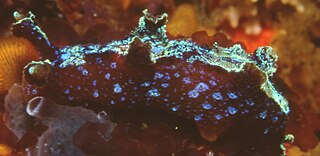
The iridescent nudibranch, Notobryon sp, is an undescribed species of scyllid nudibranch, and is found in South Africa. It is a marine gastropod mollusc in the family Scyllaeidae.

Scutellastra argenvillei or Argenville's limpet, is a species of sea snail, a true limpet, a marine gastropod mollusk in the family Patellidae, one of the families of true limpets.

Burnupena papyracea, common name the papery burnupena, is a species of sea snail, a marine gastropod mollusk in the family Buccinidae, the true whelks.
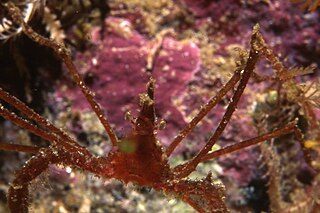
Macropodia falcifera, the Cape long-legged spider crab, is a species of marine crab found around the South African coast. It is a member of the family Inachidae.

Clinus acuminatus, the sad klipfish, is a species of fish in the family Clinidae. It is endemic to Southern Africa, where it occurs along the coast of Namibia and South Africa. It can reach a maximum length of 13 centimetres (5.1 in) TL and is viviparous. The sad klipfish feeds on crustaceans.
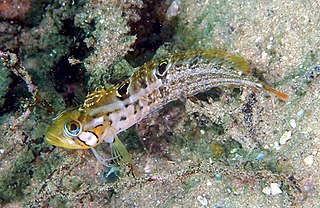
Clinus venustris, the speckled klipfish, is a species of clinid that occurs in subtropical waters of the Atlantic Ocean from Namibia to South Africa where it is found in the subtidal zone as well as being a denizen of tide pools. This species can reach a maximum length of 12 centimetres (4.7 in) TL. and feeds primarily on amphipods, isopods, mysids, and echinoderms.
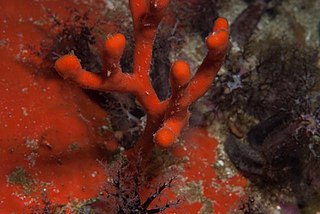
The tree sponge is a species of demosponge. It is known from the west coast of South Africa to Cape Agulhas. It is endemic to this region.

Anthothoe chilensis, or striped anemone, is a species of sea anemones in the family Sagartiidae.
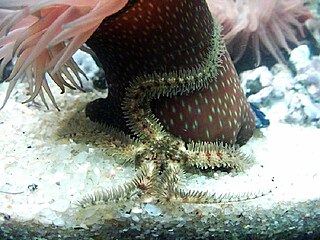
Ophiothrix fragilis is a species of brittle star in the order Ophiurida. It is found around the coasts of western Europe and is known in Britain as the common brittle star. It is also found along the coast of South Africa where it is known as the hairy brittle star.

Ligia diletata is a woodlouse in the family Ligiidae.
Exosphaeroma is a genus of marine isopod of the family Sphaeromatidae. This genus is found in shallow ocean waters worldwide. It is notable for being one of the few genera of sphaeromatid to be found in the southern reaches of the Southern Ocean. The greatest diversity of Exosphaeroma occurs in the Southern Hemisphere.
Ischnochiton bergoti, the ribbed-scale chiton, is a small polyplacophoran mollusc in the family Ischnochitonidae, endemic to the west coast of southern Africa.

Dinoplax validifossus, the Natal giant chiton, is a large polyplacophoran mollusc in the family Chaetopleuridae, found on the western coast of southern Africa. It was originally considered a subspecies of the giant chiton.

Anilocra capensis is a species of parasitic isopod in the family Cymothoidae. It is endemic to southern Africa. The species preferentially attaches itself to the hottentot.

The hottentot, also known as the hottentot seabream, is a species of sea bream in the family Sparidae, native to the southwestern coast of Africa.

Glyptidotea lichtensteini, the keeled isopod, is a medium-sized isopod in the family Idoteidae, found on the coast of southern Africa.
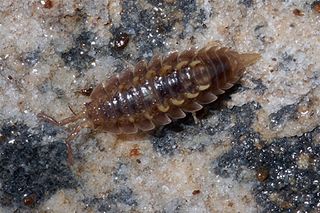
Deto echinata, the horned isopod, is a species of air-breathing isopod, or woodlouse, in the family Detonidae. It inhabits seashores in southern Africa and on some oceanic islands.

The Marine biodiversity of South Africa is the variety of living organisms that live in the seas off the coast of South Africa. It includes genetic, species and ecosystems biodiversity in a range of habitats spread over a range of ecologically varied regions, influenced by the geomorphology of the seabed and circulation of major and local water masses, which distribute both living organisms and nutrients in complex and time-variable patterns.


















